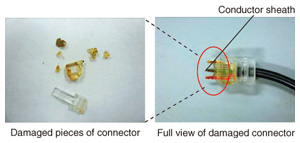 |
|||
|
|
|||
|
Practical Field Information about Telecommunication Technologies Vol. 10, No. 2, pp. 52–55, Feb. 2012. https://doi.org/10.53829/ntr201202pf1 Damage to Plastic Components Caused by Solvent CrackingAbstractThis article introduces two case studies of damage to plastic components caused by solvent cracking and the countermeasures developed by NTT EAST. It is the ninth in a bimonthly series on the theme of practical field information about telecommunication technologies. This month's contribution is from the Materials Engineering Group, Technical Assistance and Support Center, Maintenance and Service Operations Department, Network Business Headquarters.
1. IntroductionTelecommunication facilities use various materials such as metal, concrete, and plastic. Among these, plastic is widely used in equipment that comes into direct contact with customers. This article introduces two case studies of how plastic components can be damaged and the countermeasures that were taken to prevent reoccurrence. 2. Damage to latching tab of modular plug2.1 ProblemAt a certain metalworking plant in Japan, the modular plug of the helical cord of a particular telephone receiver had to be replaced repeatedly because the plug’s latching tab broke away from its base three times over the course of a five-year period (Fig. 1). The telephone set sat on a desk on the work floor and traces of cutting oil used for cutting metal plates on a lathe could be seen splattered about the desk. Grease from this cutting oil was also found on the telephone’s helical cord (Fig. 2). The damaged modular plug was made of acrylic resin.
2.2 Cause of damageSome plastic materials are known to suffer from cracking when solvents or oils adhere to locations subjected to stress. This solvent cracking is a type of environmental-stress cracking that affects plastic molded products. If a large amount of internal stress (strain) exists in a molded product that comes into contact with solvents or oils, those substances may penetrate into the product and cause intermolecular slippage and crack generation. This is accompanied by molecular exfoliation that gives rise to a highly glossy, mirror-like fractured surface. In this case study, the plug’s acrylic resin had low resistance to solvent cracking and cutting oil was found on the plug, so two of the key conditions for crack generation were present. The fractured surface of the damaged plug was observed with a digital microscope and found to be highly glossy and mirror-like without any unevenness (Fig. 3), which is a characteristic feature of solvent cracking.
To continue our investigation, we conducted an experiment to reproduce such solvent cracking using the same type of cutting oil as used at the metalworking plant. When the receiver of a telephone set is lifted off its hook, the cord is stretched, which applies stress to the latching tab, which pushes it away from its base. To simulate this process, we coated the latching tab of a new modular plug with cutting oil, applied stress to the tab’s base, and heated the tab at 80°C using a Geer oven to accelerate the reaction. After two weeks, cracks occurred at the base. Digital microscope observation of the fractured surface revealed a smooth, mirror-like surface similar to the fractured surface of the actual damaged tab at the metalworking plant (Fig. 4).
2.3 Measures to prevent reoccurrenceConnecting a modular plug to the modular socket on a receiver that has been splashed with cutting oil may cause the plug’s tab to eventually break away owing to ongoing damage caused by remnant oil. Therefore, the socket should be wiped clean of remnant grease with a cotton swab or other implement before the plug is inserted. We also recommend using a gel to fill the gap in the plug’s aperture where the spiral cord is inserted to prevent cutting oil from entering the socket. 3. Damage to connector of AC adaptor for ISDN modem3.1 ProblemIn response to a fault report stating that power could not be supplied to an ISDN (integrated services digital network) modem, an inspection found that the connector of the modem’s AC adaptor was damaged (Fig. 5). Further inspection also found the remains of ants in the socket-pin area and on the nearby circuit board, as shown in Fig. 6. There had been no reports of lightning strikes or power outages since the installation of this equipment.
3.2 Inspection resultsThe connector (made of polycarbonate material) was found to have fallen to pieces, exposing the sheathing of its conducting wires (Fig. 7). Moreover, the sheathing (made of flexible polyvinyl chloride) was also found to have surface sores (Fig. 8). A brownish adherent thought to be the remains of ants was found inside the damaged connector and the charred remains of an ant were found on the circuit board near the socket.
3.3 Cause of damageWe analyzed the brownish adherent in the damaged connector by ion chromatography and found the presence of formic acid (HCOO–), as indicated in Table 1. While connector damage due to formic acid was therefore suspect, microscopic observation of the connector at the breaks revealed smooth, mirror-like fractured surfaces. We therefore investigated the possibility that solvent cracking was the cause of this damage. The abovementioned charred ant remains found on the circuit board near the socket led us to believe that an ant had entered through gaps in the modem’s enclosure and made contact with metal pins causing an electrical short and consequently generating high temperatures. Furthermore, taking into account the presence of sores on conductor sheaths near that circuit board, we considered that those sheaths were also heated when the electrical circuit shorted. We therefore surmised that the heating of conductor sheaths in this way could cause plasticizing agent to separate from the sheath and come into contact with the polycarbonate connector, thereby generating solvent cracking. Infrared reflection spectroscopic measurements of these conductor sheaths confirmed the presence of a phthalate ester plasticizer. The penetration of phthalate ester plasticizer into polycarbonate resin is known to facilitate solvent cracking. We therefore concluded that solvent cracking was probably the reason for the damage to the AC-adaptor connector in this case study.
4. ConclusionThis article introduced case studies of damage to plastic components caused by solvent cracking. When materials that contain solvents (such as adhesives, paints, and oils) are used near equipment containing plastic components, special care must be taken to ensure that such materials do not adhere to the equipment. We hope that this article has been useful in helping the reader obtain a better understanding of material deterioration. |
|||
















